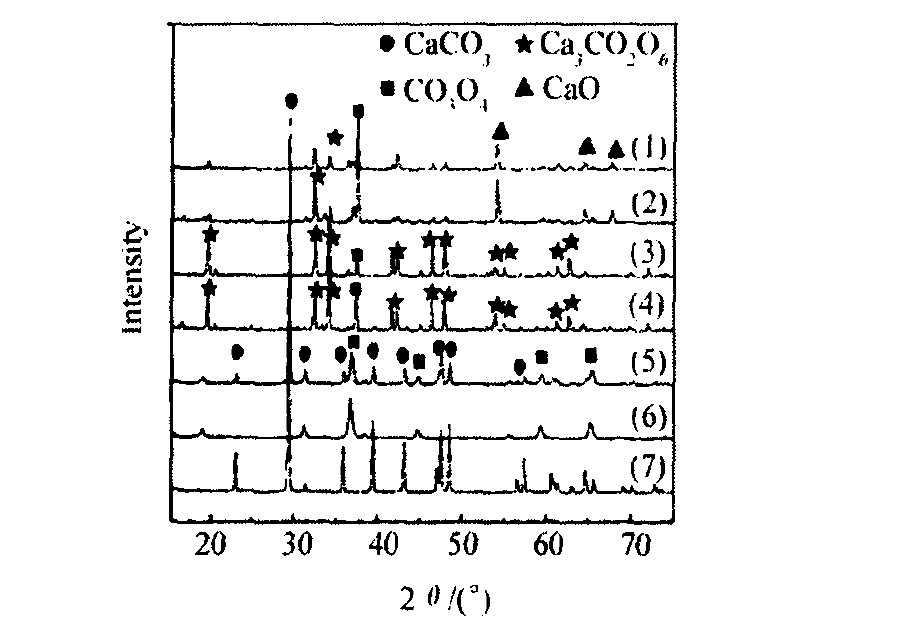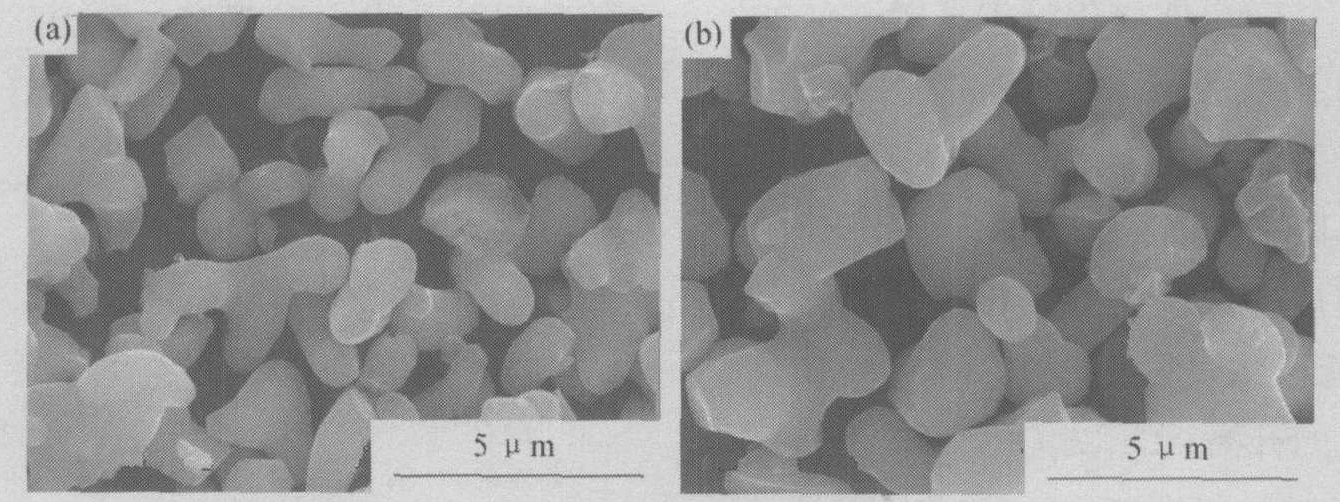Ca3Co2O6块体的放电等离子烧结及热电性能研究
北京工业大学材料学院新型功能材料教育部重点实验室,北京工业大学材料学院新型功能材料教育部重点实验室,北京工业大学材料学院新型功能材料教育部重点实验室,北京工业大学材料学院新型功能材料教育部重点实验室 北京100022,北京100022,北京100022,北京100022
摘 要:
采用短时固相反应和放电等离子烧结 (SR-SPS) 方法, 制备了单相多晶Ca3Co2O6陶瓷块, 系统研究了制备条件及烧结工艺对Ca3Co2O6陶瓷块显微结构及热电性能的影响。研究表明, 950℃下固相反应2 h即能得到单相树枝状, 尺寸约13μm的Ca3Co2O6粉末, 延长焙烧时间虽然对物相影响不大, 但会引起粉末颗粒长大, 不利于SPS烧结;SPS烧结温度强烈影响着Ca3Co2O6陶瓷块的制备, 本实验范围内, Ca3Co2O6陶瓷块体的最佳制备条件为950℃固相反应2 h, SPS 900℃保温5 min, 此时Ca3Co2O6陶瓷块具有p型半导体特性, 电阻率ρ随温度的升高急剧下降, 然后趋于平缓 (高于600℃) ;Seebeck系数S随温度 (100℃以上) 升高稍有下降, 热导率κ表现为先下降后增加, 在500℃时仅为1.73 W.m-1.K-1。综合电性能与热性能结果, 其无量纲因子ZT随温度升高呈上升趋势, 在本实验范围内, 于700℃下达到最高值0.02。
关键词:
中图分类号: TN305
收稿日期:2005-04-10
基金:国家自然科学基金 (50271001);北京市教委科技发展重点资助项目 (KZ200310005001);国家发改委资助项目;
Research on Spark Plasma Sintering and Thermoelectric Properties of Ca3Co2O6 Bulk
Abstract:
Short-time solid reaction and spark plasma sintering method (SR-SPS) was used to prepare single-phase polycrystalline Ca3Co2O6 ceramic bulk, and effects of preparation condition and sintering technology were investigated in detail.Single-phase dendritic Ca3Co2O6 powders with grain size of about 1~3 μm were obtained under 950 ℃ for 2 h by solid-state reaction process, and prolonged reaction time could hardly influence phase structure, but it could make grain size growth, which is harmful for SPS sintering.Temperature of SPS strongly affects the preparation of Ca3Co2O6 ceramic bulk.In our experimental range, the best condition for Ca3Co2O6 ceramic bulk is to react under 950 ℃ for 2 h, and then sinter under 900 ℃ for 5 min by SPS.The bulk obtained by above technology shows character of p-type semiconductor, electrical resistivity ρ decrease sharply and then slightly, Seebeck coefficient S reduces, thermal conductivity κ decreases and then increases with increasing temperature, the minimum value of κ is 1.73 (W·m-1·K-1) at 500 ℃.As a result, the figureless factor of merit ZT shows increasing trend and the maximum value of ZT reaches 0.02 at 700 ℃ in our experimental range.
Keyword:
Ca3Co2O6 bulk;SPS;microstructure;thermoelectric properties;
Received: 2005-04-10
近年来, 随着国内外对新型环境材料、 能源材料及能量转换材料的关注, 热电材料也备受人们的瞩目
1 实验
用Co3O4 (≥98.5%, 天津津科精细化工研究所) , CaCO3 (≥98.0%, 北京市红星化工厂) 粉末为起始原料。 将一定化学计量比的Co3O4与CaCO3粉末, 放入GN-2型高能球磨机中, 在酒精介质下混合, 然后置于烘箱中干燥, 待完全干燥后, 于不同条件下高温煅烧。 将经过煅烧的粉末倒入圆柱形石墨模具中, 压实后用日本住友石炭生产的DR.SINTER-SPS-3.20烧结系统在一定条件下烧结, 得到块状烧结产物。 样品的相组成用粉末X射线衍射方法 (日本理学Dmax-3CX, Cu Kα) 确定。 样品的断口形貌采用日立公司S-450型扫描电子显微镜观察。 烧结得到的块体用线切割机将其切割成测电性能的长条 (3 mm×3 mm×18 mm) 和测热导率的圆片 (Φ 10 mm×1 mm) , 并将试样表面打磨干净。 采用日本真空理工生产的ZEM-2型Seebeck系数和电阻率测试仪, 用标准四端子法测试Seebeck系数及电阻率, 用激光微扰法 (真空理工TC-7000H型激光热导仪) 测试样品的热导率。 性能测量在室温~700 ℃的范围内进行。
2 结果与讨论
图1是不同温度下反应8 h后粉末产物的XRD图谱。 我们发现, 反应温度为600 ℃并处理一定时间, 基本没有发生反应, 产物中除了原有的Co3O4和CaCO3外, 基本没有其他相出现, 即使将处理时间延长到48 h, 仍旧为Co3O4和CaCO3混合物; 将反应温度提高至900 ℃后出现了一些Ca3Co2O6相, 但Co3O4特征峰仍很明显; 温度提高到950 ℃时, Ca3Co2O6成相已较为理想, Co3O4特征峰也已弱化, 此时产物基本上是Ca3Co2O6相; 温度提高到1000 ℃以上时, 不但几乎看不到Ca3Co2O6特征峰, 还出现了大量CaO相, 分析认为可能是Ca3Co2O6相分解所致。 这与文献
图1 不同固相反应温度下粉末的XRDFig.1 XRD patterns of Ca3Co2O6powders under different solid reaction temperatures
(1) 1050℃; (2) 1000℃; (3) 950℃; (4) 900℃; (5) 600℃; (6) Co3O4; (7) CaCo3
图2 不同反应时间粉末的XRD图谱 (950 ℃)
Fig.2 XRD patterns of Ca3Co2O6 powders under different times
图3为950 ℃固相反应2和8 h后粉末产物在10000倍下的SEM形貌。 从图中看出固相反应2 h得到的粉末颗粒均匀, 大都呈树枝状, 约1~3 μm; 而预处理8 h的产物, 晶粒略有长大, 约2~4 μm。
热电器件的开发必须使用致密的块体Ca3Co2O6热电材料, 因此, 我们采用先进的SPS技术, 利用其加热均匀, 升温速度快, 生产效率高, 产品组织细小均匀, 能保持原材料的自然状态, 操作简单等优点, 在不同条件下对粉末样品进行烧结。 图4为不同SPS温度下烧结体的断口SEM形貌。 可以看出, 烧结产物的形貌与固相反应温度和时间有密切关系。 首先, 随烧结温度的升高, 烧结现象变得明显。 当SPS 600 ℃时, 如图4 (a) 所示, 基本无烧结情况, 类似于未烧结粉末状; 温度升至900 ℃时, 如图4 (b) 所示, 颗粒界限已开始模糊, 略微出现烧结现象, 但烧结现象仍不十分明显; 而固相反应4 h的烧结体则表现出较明显的烧结现象, 如图4 (c) 所示, 其晶界较模糊, 部分晶界已经相互融合。 当对固相反应2 h后的粉末进行900 ℃SPS烧结时, 其断口如图4 (d) 所示, 烧结现象十分明显, 颗粒与颗粒间相互融合, 此外, 只有该条件下的粉末经900 ℃放电等离子烧结后能够得到具有较高强度和韧性和块体材料。 这也说明, 预处理时间越短, 颗粒越细, 对SPS烧结越有利, 该结论也与SPS烧结曲线的分析结果相一致。
图3 950 ℃下固相反应2 h (a) 和8 h (b) 粉末产物的形貌
Fig.3 SEM of powders under SR-950 ℃ for 2 h (a) and 8 h (b)
图4 不同SPS条件下烧结体的SEM图Fig.4 SEM of Ca3Co2O6bulk sintered under different conditions
(a) 固相反应950℃, 8 h, SPS 600℃-5 min; (b) 固相反应950℃, 8 h, SPS 900℃-5 min; (c) 固相反应950℃, 4 h, SPS 900℃-5 min; (d) 固相反应950℃, 2 h, SPS 900℃-5 min
图5 Ca3Co2O6块体热电性能与温度的关系曲线Fig.5 Temperature dependence of thermoelectric properties for Ca3Co2O6bulk
(a) 电阻率; (b) 赛贝克系数; (c) 热导率; (d) 无量纲优值
图5分别为经950 ℃固相反应2 h及SPS 900 ℃烧结5 min得到的块体Ca3Co2O6热电材料的热电性能对温度的变化曲线。 图5 (a) 可以看出, 产物的电性能具有半导体的电学特征, 当测试温度在600 ℃以下时, 其电阻率ρ随温度的升高急剧下降, 高于600 ℃时, 随温度变化趋于平缓, 在700 ℃时的电阻率降低到7.34×10-4 Ω·m; 图5 (b) 显示产物的Seebeck系数S均为正值, 说明产物具有p型半导体特性, 其数值随温度 (100 ℃以上) 升高有所下降, 这与电阻率随温度的变化趋势相吻合, 可能是产物中载流子浓度随温度升高而增加的缘故。 此外, 随温度的升高, Ca3Co2O6陶瓷的热导率κ表现为先下降后增加的趋势, 在773 K达到最低值, 仅为1.73 W·m-1·K-1, 综合电性能与热性能结果, 其在700 ℃下的无量纲因子ZT (ZT=S2T/ρκ) 达到0.02, 并且该值随温度升高呈上升趋势。
3 结论
通过950 ℃固相反应2 h, 可以得到单相、 颗粒尺寸为1~3 μm的树枝状多晶粉末, 其在900 ℃下经放电等离子烧结5 min, 即可得到较致密的Ca3Co2O6块体, 该块体具有p型半导体特性, 电阻率ρ随温度的升高急剧下降, 然后, 随温度 (高于600 ℃时) 变化趋于平缓; Seebeck系数S随温度 (100 ℃以上) 升高有所下降, 热导率κ表现为先下降后增加的趋势, 在500 ℃时仅为1.73 W·m-1·K-1。 综合电性能与热性能结果, 其无量纲因子ZT随温度升高呈上升趋势, 于700 ℃下达到最高值0.02, 并且该值随温度升高呈上升趋势。
参考文献







